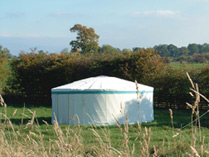 |

 |
 |
 |
 |
 |
 |

 |

 |
 |
 |
 |
 |

Yurts originally evolved in Central Asia, as a portable home for nomadic peoples.

Over time the design developed to suit different climates, as these ancient populations, living in some of the most hostile and desolate places, became more ingenious and able to adapt the structures. The circular body of the Yurt and low profile of the roof ensures greater stability against wind and poor weather conditions, as well as making it easier to heat during the cold months. |
 |
 |
 |
 |
 |

 |
 |
 |

“It is difficult to define why circular shapes hold such a special magic and fascination. Maybe it is their natural affinity with the cycle of life – the movement of the sun, moon, and stars, and the cycle of the seasons. Maybe it is some archetypal memory of, and resonance with, former circle homes and round houses of our forebears. Whatever it is, you will be pleasantly surprised at the happy and peaceful effect that circular structures will have on you!”

David Pearson – ‘Yurts, Tipis and Benders’ - Gia Books Ltd 2001. |

 |
 |
 |
 |
 |
 |

 |
 |
 |

|
 |
 |
 |
 |
Our company background was in custom made joinery and furniture making, but diversified in 2001 when we began to replicate this ancient design, using modern materials and production techniques, for greater ease, speed, and safety of assembly and disassembly.

Wildwood Cumbria began solely manufacturing Yurts and customised features for Yurts in 2002, when it became apparent that the structures could be used for such a wealth of purposes. The greater part of our business caters for clients who wish to purchase yurts for permanent use, however, we also supply our product to those who want to hire them for a one off event. |
 |
 |
 |
 |
 |
|
 |
 |
 |
 |
 |
|
 |